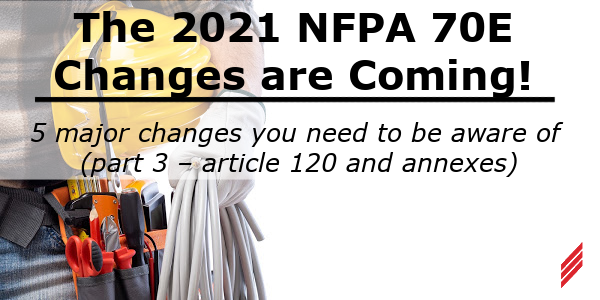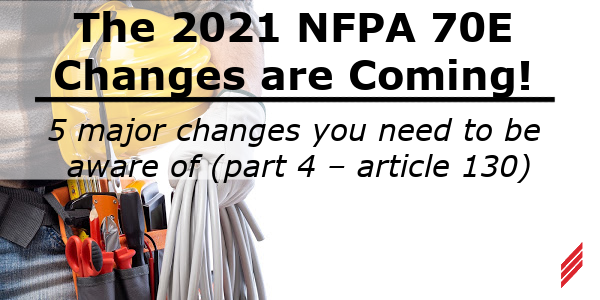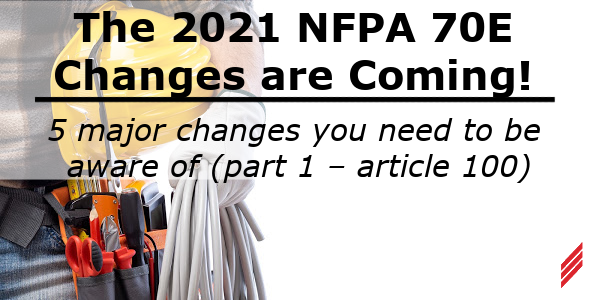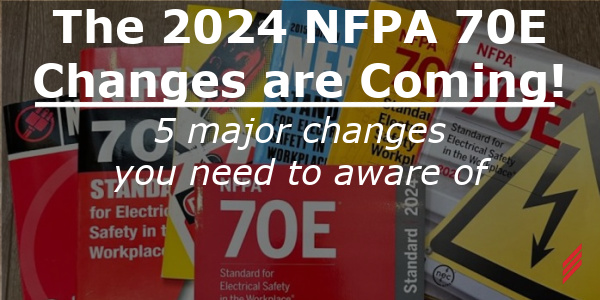The 2021 NFPA 70E Changes are Coming! 5 Major Changes You Need to be Aware of (Part 3 – Article 120 and Annexes)
by Scott King, PMP on Nov 17, 2020 10:30:00 AM

Another 3 years has passed and it’s time for another NFPA 70E update. This new update will be the 2021 version. This document will provide a brief summary of the proposed changes. Please note that these changes have not yet been fully adopted, but they provide a fair representation of what’s likely going to be in the final version.
I was fortunate to get a sneak preview to the proposed changes by attending a webinar in July 2020 hosted by Jim Phillips of brainfiller. Jim is a Technical Committee Member of the NFPA 70E Standard for Electrical Safety in the Workplace and is well respected in the electrical industry.
I have written a series of blogs on the proposed changes, organized by Article:
Existing text from 2018 is provided, with changes shown as either strikethrough for deletions or in RED for changes.
Changes to Article 120 (Establishing an Electrically Safe Work Condition):
Remember when we talked about “it is a “State” where the hazards (electrical conductors and circuit parts) that a worker may be exposed are maintained in a deenergized “State” for the purpose of temporarily eliminating the electrical hazards”? And I mentioned that this is not the procedure to eliminating the hazards? Well, this section is the Procedure and there were a few revisions to this Article.
- Section 120.2(B) Lockout/Tagout Procedure. The following language was added to the end of the paragraph:
.png?width=300&name=Lock%20out%20tag%20out%20procedures%20(6).png)
- “The procedure shall meet the requirements of applicable codes, standards, and regulations for lockout and tagging of electrical sources”
- Essentially, any lockout/tagout procedure needs to meet relevant requirements and regulations.
- This section also requires “up-to-date” drawings and diagrams. Unfortunately, this is never the case in all the arc flash studies I have ever completed. However, the benefits of doing an arc flash analysis is that one of the deliverables “will be” up-to-date diagrams.
- Section 120.3(C) Lockout Device. This section was modified to align with OSHA 1910.333(b)(2)(iii)(E). The following language was added to the end of the paragraph:
- “provided that all of the following conditions exist:
- Only one circuit or piece of equipment is de-energized
- The lockout period does not extend beyond the work shift
- Employees exposed to the hazards associated with re-energizing the circuit or equipment are familiar with this procedure”
- Section 120.4 Lockout/Tagout Procedures.
- 4(B)(2) Stored Energy. A new informational note was added about capacitors and discharge. The language reads:
- “For more information on methods and procedures to place capacitors in an electrically safe work condition, see 360.4, 360.5, and Informative Annex R, Working Capacitors”. Articles 360 and Annex R are new dealing with capacitor safety. For more detailed information about Article 360, you can refer to the July 2020 issue of Electrical Contractor Magazine “2021 NFPA Article 360” https://www.ecmag.com/magazine/volume/july-2020
- 5 Process for Establishing and Verifying an Electrically Safe Work Condition. The following revised language was changed because it was too broad:
- 5(5) “Block or release stored non-electrical energy devices that could re-energize electric circuit parts to the extent that the circuit parts could not be accidently energized by the device”.
- 5(7) Informational note No. 3 was added: “For additional information on rating and design requirements for permanently mounted absence of voltage testers, refer to UL 1436, Outlet Circuit Testers and Other Similar Indicating Devices”. In my interpretation, it is not clear if this is a new informational note or exception.

- 4(B)(2) Stored Energy. A new informational note was added about capacitors and discharge. The language reads:
- “provided that all of the following conditions exist:
- “The procedure shall meet the requirements of applicable codes, standards, and regulations for lockout and tagging of electrical sources”
Annexes D, F and R and Q&A: Major changes to the Annex’s, especially Annex D, impart to the revised IEEE 1584 2018 Standard. The information below is a partial listing of some of the changes:
- Annex D: Incident Energy and Arc Flash Boundary Calculation Method
- The calculation methods and formulas from the previous NFPA 70E version had calculation methods from the late 1990’s, equations from IEEE 1584 – 2002 and equations from some technical papers pertaining to DC Arc Flash. Since the new version of IEEE 1584 – 2018 has come out, there have been significant changes and complexity to the equations and tables. Many tables have been added with “K” values and coefficients. Because of the complexity and size of the new IEEE version, the decision was made to remove the equations from Annex D since it would be to overwhelming.
- Therefore, the revised Annex D will have information (overview) about the IEEE 1584 2018 standard.
- Annex F: Risk Assessment and Risk Control
- A new section F.7 Battery Risk Assessment was added to provide guidance for users on how to select PPE using a battery risk assessment process when multiple hazards are present.
- “Multiple hazards may be encountered when working on batteries (shock, arc flash, chemical, thermal). PPE selection should take into account all of the hazards depending on the task. The flow chart displayed in Figure F.7 will assist users to assess all hazards associated with work on batteries”.
- Informative Annex R: Working with Capacitors. This section is completely new and added to the new 2021 version with a good deal of additional information regarding capacitors including the following sections:
- “R.1 Introduction
- 2 Qualification and Training
- 3 Shock Hazard
- 4 Short Circuit Hazard
- 5 Internal Rupture
- 6 Performing a Risk Assessment to Capacitors
- 7 Determining the Shock Hazard
- 8 Determining Capacitor Stored Energy
- 9 Determining the Arc Flash Hazard
- 10 Determining the Arc Blast Hazard
- 11 Selecting the Appropriate Test and Grounding Methods”
- Lots of equations and calculations.
I realize there is a good deal of information here to digest but I hope this gives you an idea of what’s to come. I want to thank Jim Phillips for helping us all learn more about the proposed NFPA 70E 2021 changes. As always, if you have any questions or want to learn more, please feel free to reach out to me anytime.
About the Author:
Scott King is the VP & National Director of Electrical Safety Services. Scott has been with Hallam-ICS for over 30 years. Scott and his team have been conducting power system studies for over 15 years.
Read My Hallam Story
About Hallam-ICS:
Hallam-ICS is an engineering and automation company that designs MEP systems for facilities and plants, engineers control and automation solutions, and ensures safety and regulatory compliance through arc flash studies, commissioning, and validation. Our offices are located in Massachusetts, Connecticut, New York, Vermont and North Carolina and our projects take us world-wide.
You May Also Like
These Related Stories

The 2021 NFPA 70E Changes are Coming! 5 Major Changes You Need to be Aware of (Part 4 – Article 130)

The 2021 NFPA 70E Changes are Coming! 5 Major Changes You Need to be Aware of (Part 1 – Article 100)




No Comments Yet
Let us know what you think